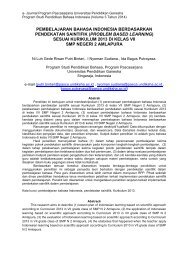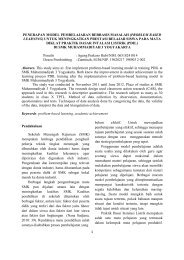You also want an ePaper? Increase the reach of your titles
YUMPU automatically turns print PDFs into web optimized ePapers that Google loves.
The periodic table<br />
Show you can...<br />
Copy and complete the table:<br />
Element<br />
He<br />
Ar<br />
Reactive or<br />
unreactive?<br />
Metal or<br />
non-metal?<br />
Solid, liquid or<br />
gas at room<br />
temperature?<br />
Electronic<br />
structure<br />
KEY TERM<br />
Alkali metals The elements in Group 1<br />
of the periodic table (including lithium,<br />
sodium and potassium).<br />
● Group 1 – the alkali metals<br />
The main elements of Group 1 are lithium, sodium, potassium, rubidium<br />
and caesium. They are known as the alkali metals. They are all soft<br />
metals that can be cut with a knife. They are very reactive and so are<br />
stored in bottles of oil to stop them reacting with water and oxygen.<br />
Li<br />
Na<br />
K<br />
Rb<br />
Cs<br />
Fr<br />
▲ Figure 1.3 The alkali metals are all<br />
soft and can be cut with a knife.<br />
Element Formula Appearance<br />
at room<br />
temperature<br />
Number of<br />
electrons in<br />
outer shell<br />
Relative<br />
mass of<br />
atoms<br />
Melting<br />
point<br />
in °C<br />
Density<br />
in g/cm 3<br />
Lithium Li Silvery-grey metal 1 7 180 0.53<br />
Sodium Na Silvery-grey metal 1 23 98 0.97<br />
Potassium K Silvery-grey metal 1 39 63 0.89<br />
Rubidium Rb Silvery-grey metal 1 85 39 1.53<br />
Caesium Cs Silvery-grey metal 1 133 28 1.93<br />
Metals or non-metals?<br />
Melting points<br />
Density<br />
Reaction with<br />
non-metals<br />
Reaction with water<br />
Compounds made<br />
from Group 1 metals<br />
Properties of the alkali metals<br />
• A ll the elements are metals.<br />
• T he alkali metals are all solids at room temperature.<br />
• T he melting points decrease as the atoms get bigger going down the group.<br />
• T he alkali metals have low densities for metals.<br />
• L ithium, sodium and potassium all float on water as they are less dense than water.<br />
• The metals all react easily with non-metals by the transfer of electrons from the metal to the non-metal forming<br />
compounds made of ions.<br />
• Alkali metals always form 1+ ions (e.g. Li + , Na + , K + , Rb + , Cs + ) as they have one electron in their outer shell which<br />
they lose when they react to get a full outer shell.<br />
• The alkali metals all react with water, releasing hydrogen gas and forming a solution containing a metal<br />
hydroxide: alkali metal + water → metal hydroxide + hydrogen:<br />
e.g. 2Na + 2H 2 O → 2 NaOH + H 2<br />
• T he solution of the metal hydroxide that is formed is alkaline.<br />
• C ompounds made from alkali metals:<br />
• a re ionic<br />
• a re white solids<br />
• d issolve in water to form colourless solutions<br />
15





